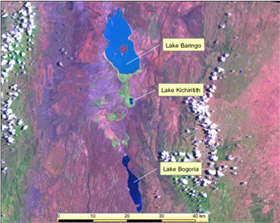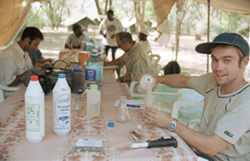|
|
 |
LAKE BARINGO
Lake
Baringo is a fresh water lake situated some
five hours drive to the north of Naivasha.
The climate is arid and hot. The area is
rather undeveloped with still a relatively
low, although rapidly growing, population.
The local economy is based on goat herding
and small scale agriculture, near streams;
there is also some tourism and fishing was
an important, albeit small, industry until
it collapsed some years ago. Being a freshwater
lake, Lake Baringo has populations of hippopotamus
and crocodiles as well as an abundant and
impressive bird life.
|
Earthwatch started working on the Lake in 2001, with the objective to further
our understanding of the physical and ecological parameters that govern lake
variability. This has entailed collecting data on physical, physico-chemical
and biological parameters:
(i) Monitoring of water quality in the lake and its catchment,
(ii) Investigations of macrophytes; species lists and distribution.
(iii) Investigations of plankton, species lists and distribution.
(iv) Investigations of aquatic macroinvertebrates in the lake and the catchment;
species lists and distribution.
(v) Investigations of fish; species lists, distribution, and biomass.
Water levels and rainfall have varied markedly during the period of investigation.
|

|
 |
These
variations have, in turn, been associated
with variations in the salinity and the concentration
of suspended solids in the Lake. Lake conductivity
is controlled by the balance of fresh water
inflow from rivers in the South and South
Easterly parts, and evaporation in the main
Lake. Turbidity is caused by the inflow of
fine inorganic material via the rivers, and
the re-suspension of this material in the
extensive shallow areas of the Lake |
A number of important findings have emerged
showing that:
- Lake Baringo is a highly variable system,
governed primarily by changes in lake levels.
These
changes are well correlated with changes in Water quality,
Lake vegetation, and in the composition
of plankton community.
- Lake Baringo is very turbid, the turbidity
in turn caused to near 100% by inorganic
processes
(erosion)
- Comparisons with conditions in the main
lake, with a smaller and more secluded lake
situated to
the South (called Lake Kichiritith) suggests that the
productivity of the main lake could be
higher. The turbid waters are likely the
most important factor
in constraining biological production.
The findings, in turn, have important implications
for management. It is clear that land use
changes, mainly over grazing and the clearing
of swamp vegetation
are threatening the longer term survival
of the lake, and are already impacting
severely on the lake and
its ecosystems. These problems need to
be addressed urgently.
Water quality
- The high conductivity and high content
of suspended sediment in the lake implies
significant
constraints
for aquatic biota. Areas with better water
quality may be found: (i) in the southern
part of the Lake,
near the two main rivers’ combined
outflows; and (ii) in the small lake.
- Physico chemical conditions vary between
years. There is also a water quality gradient
in the main lake,
with fresher water in the south and more
alkaline conditions in the north. A plume
of fresh water
entering the lake can be seen on the Landsat image below.
Sediment
Samples of Lake Bottom sediments have been taken, both sediment cores and grab
samples. The key findings are:
- The sediment is near 100% inorganic in origin, showing that the lakes turbidity
is caused by inorganic processes (i.e. erosion of fine volcanic soils in the
catchment).
- The sediment consists of fine silt and clay, material which settle slowly and
which is easily re-suspended by wave action.
Plankton
- High sediment-driven turbidity is limiting light transparency such that only
buoyant Microcystis sp. colonies thrive. Baringo also has very limited zooplankton,
probably because of the limited food supply.
- The conditions in the small lake are different, with a fairly diverse phyto
and
zoo plankton, similar to conditions in Lake Naivasha.
- Algal chlorophyll a levels are lower in the main lake compared to Kichiritith,
whereas nutrient levels are higher. This suggest an under utilized system in
the main lake, probably caused by the high turbidity (conductivity may also be
important). |
 |
|
 |
Fish
Work on fish has been done in 2001, 2002 and 2004. The key findings from this
year are:
- Following a 2 year closure, the commercial fishery reopened in February 2004.
Despite the closure, catches have not returned to their level of 2000 and remain
depressed.
- The traditional species targeted in the fishery is the tilapia, Oreochromis
niloticus
baringoensis. The market value of these species is very low for fish <20cm,
with value only increasing for fish above this size. The Earthwatch samples contained
no tilapia >20cm, indicating that these fish may be rare in the lake at present.
- Interviews with both the regulated fishermen and the District Fisheries Officer
indicated widespread dissatisfaction with the present situation in the fishery.
All stakeholders were desperate for information that will enable a management
strategy to be formulated that aims to produce a viable fishery that is sustainable
in the long term. |
|
Macrophytes
and other vegetation
Detailed surveys were undertaken in 2001 and 2003 show that vegetation in the
Lake vary greatly between years. For example, in 2003, lagoons in the main lake
(mainly in the south and east) supported a dense mat of aquatic plants, dominated
by the blue water lily, floating Pistia stratiodes with submerged macrophytes
underneath. In 2002, such vegetation was absent. In 2003, there was some floating
and submerged vegetation. |
|
|
|
|
|